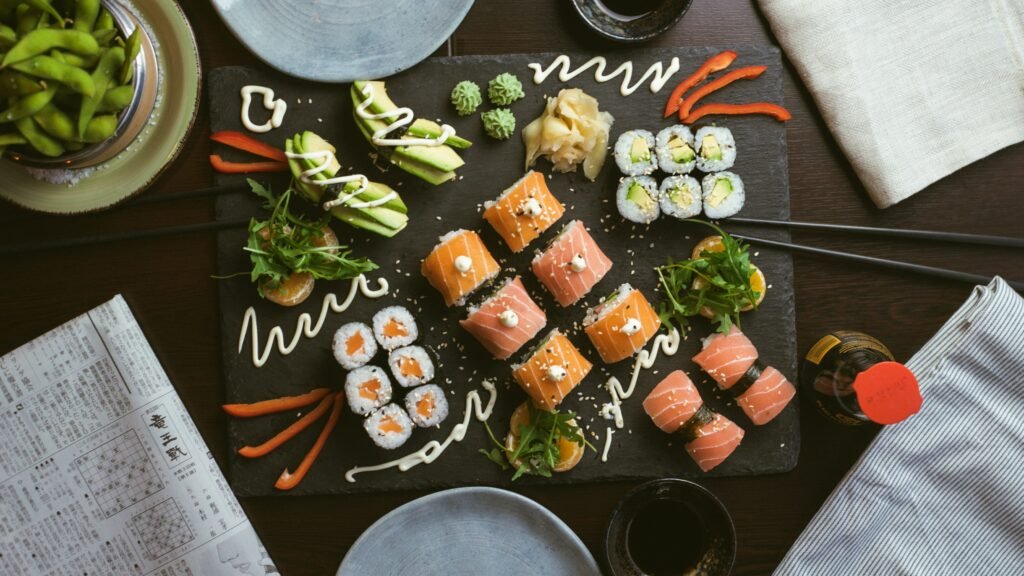Are you ready to take your summer barbecue to the next level? Look no further than the Best Caribbean Dishes for a Summer Barbecue. From succulent jerk chicken to flavorful plantain salad, this article will guide you through a mouthwatering journey of Caribbean cuisine that will have your guests coming back for seconds. So fire up the grill, grab your tongs, and get ready to add some sizzling Caribbean flavor to your next backyard gathering.
Jerk Chicken
Origin and Description
Jerk Chicken is a popular Caribbean dish that originated in Jamaica. It is known for its spicy and smoky flavors, which are achieved through a special marinade and grilling technique. The dish dates back to the indigenous Taino people of Jamaica, who used a similar cooking method called “barbacoa.”
Jerk Chicken is typically made with chicken pieces that are marinated in a mixture of spices, herbs, and other ingredients. The marinade is what gives the chicken its distinctive flavor and heat. The spices commonly used in jerk seasoning include allspice, thyme, cinnamon, nutmeg, and scotch bonnet peppers. The chicken is then grilled over a hot fire, traditionally using pimento wood, to further enhance the smoky flavor.
Ingredients and Marinade
To make jerk chicken, you will need the following ingredients: chicken pieces (such as drumsticks, thighs, or breast), allspice, thyme, cinnamon, nutmeg, scotch bonnet peppers (or habanero peppers as a substitute), garlic, ginger, soy sauce, brown sugar, vinegar, olive oil, and salt.
To prepare the marinade, combine all the spices, herbs, peppers, garlic, ginger, soy sauce, brown sugar, vinegar, olive oil, and salt in a blender or food processor. Blend until smooth to create a thick paste. Coat the chicken pieces evenly with the marinade, making sure to massage it into the meat. Allow the chicken to marinate for at least 2 hours, or overnight for the best flavor.
Grilling Techniques
Grilling jerk chicken requires a hot fire and indirect heat. If using a charcoal grill, set up a two-zone fire by placing the lit coals on one side of the grill and leaving the other side empty. If using a gas grill, preheat one side to high heat and leave the other side off.
Place the marinated chicken pieces on the cooler side of the grill, skin side up. Close the lid and allow the chicken to cook indirectly for about 30 minutes, or until the internal temperature reaches 165°F (74°C). For added flavor, you can throw some soaked pimento wood chips or fresh bay leaves onto the hot coals or grill grates.
Once the chicken is cooked, move it to the hot side of the grill to finish. Rotate the pieces occasionally to ensure even charring and caramelization. Cook for an additional 5-10 minutes, or until the skin is crispy and nicely charred.
Serving Suggestions
Jerk chicken is typically served with traditional Caribbean sides like rice and peas, fried plantains, and coleslaw. It pairs well with a refreshing tropical drink, such as a Jamaican rum punch or a fresh fruit smoothie. For added heat, serve with a side of extra jerk sauce or hot pepper sauce. Enjoy the smoky, spicy flavors of this Caribbean delicacy at your summer barbecue!
Ropa Vieja
Origin and Description
Ropa Vieja is a savory and flavorful dish that has its roots in Cuba. Its name translates to “old clothes” in Spanish, which refers to the shredded appearance of the meat in the dish. Ropa Vieja is a hearty and comforting meal that is perfect for a summer barbecue.
Legend has it that Ropa Vieja originated when a poor man had nothing to feed his family but a few scraps of meat and vegetables. Desperate to provide a satisfying meal, he cooked the meat for an extended period of time, resulting in tender, shredded meat that resembled old, torn clothes. Despite its humble beginnings, Ropa Vieja has become a beloved dish in the Caribbean and beyond.
Ingredients and Preparation
To make Ropa Vieja, you will need the following ingredients: flank steak, bell peppers, onions, garlic, tomatoes, beef broth, cumin, oregano, bay leaves, salt, and pepper.
Start by searing the flank steak in a hot skillet until browned on both sides. Remove the steak from the skillet and set it aside. In the same skillet, sauté the bell peppers, onions, and garlic until softened. Add the tomatoes, beef broth, cumin, oregano, bay leaves, salt, and pepper to the skillet. Bring the mixture to a boil, then reduce the heat and simmer for about 2 hours, or until the meat is tender and easily shreds apart.
Once the meat is tender, remove it from the skillet and shred it using two forks. Return the shredded meat to the skillet and cook for an additional 30 minutes to allow the flavors to meld together. Adjust the seasoning if necessary.
Grilling Techniques
While Ropa Vieja is traditionally prepared over a stovetop, you can adapt the recipe for the grill to add a smoky flavor to the dish. After simmering the meat in the tomato-based broth, transfer it to a grill-safe pan or tray. Place the pan on the grill over medium heat and cook for an additional 15-20 minutes, or until the meat has absorbed some of the smoky flavor from the grill.
Serving Suggestions
Ropa Vieja is typically served over white rice with black beans and fried plantains. You can also enjoy it with a side of warm tortillas for a Cuban twist on tacos. Garnish with fresh cilantro, sliced avocado, or a squeeze of lime juice before serving. Accompany the dish with a classic Cuban cocktail like a mojito or a Cuba Libre. The rich, tender meat and flavorful tomato sauce of Ropa Vieja are sure to impress your guests at your summer barbecue.

Ceviche
Origin and Description
Ceviche is a light and refreshing dish that originated in the coastal regions of Latin America, including Peru, Ecuador, and Mexico. It is a popular choice for summer barbecues due to its bright flavors and minimal cooking involved. Ceviche is made by marinating raw seafood or fish in citrus juice, which “cooks” the proteins and imparts a tangy flavor.
The exact origins of ceviche are debated, with various countries claiming it as their own. In Peru, ceviche is considered a national dish and has been enjoyed for centuries. The acidic marinade was traditionally made using the juice of a local citrus fruit called the “limón de pica.” Today, different variations of ceviche exist across the Caribbean and Latin American regions, each with its unique twist on the dish.
Ingredients and Preparation
The ingredients for ceviche can vary depending on personal preference and regional variations. However, the basic components include fresh seafood or fish, citrus juice (typically lime or lemon), onions, chili peppers, cilantro, salt, and pepper.
Start by cutting the seafood or fish into small, bite-sized pieces. It is important to use fresh and high-quality ingredients for ceviche since the seafood is not cooked in the traditional sense. Place the seafood in a bowl and add the citrus juice, making sure it covers the seafood entirely. Let it marinate in the refrigerator for about 30 minutes to 1 hour, or until the seafood is “cooked” to your desired tenderness.
While the seafood marinates, finely chop the onions, chili peppers, and cilantro. These ingredients will add flavor and texture to the ceviche. Once the seafood is ready, drain any excess citrus juice from the bowl and add the chopped onions, chili peppers, cilantro, salt, and pepper. Mix everything together gently to ensure the flavors are evenly distributed.
Grilling Techniques
Since ceviche is traditionally made without any cooking, there are no specific grilling techniques involved. However, you can enhance the smoky flavors by grilling the seafood or fish before marinating it in the citrus juice. Grill the seafood over medium-high heat until it is lightly charred and cooked through. Let it cool before proceeding with the ceviche marinade.
Serving Suggestions
Ceviche is typically served as an appetizer or a light main course. It can be enjoyed on its own or served with crispy tortilla chips, corn tortillas, or even plantain chips. Garnish with additional cilantro leaves and lime wedges for added freshness. Pair ceviche with a refreshing Latin American cocktail like a classic pisco sour or a margarita. The bright, tangy flavors of ceviche are perfect for a summer barbecue, offering a delightful taste of the Caribbean and Latin America.
Roti
Origin and Description
Roti is a popular Caribbean staple that originated in the Indian subcontinent. It is a type of flatbread that is made from a simple dough consisting of flour, water, and sometimes oil. Roti is a versatile dish that can be paired with various curries, stews, or used as a wrap for meats and vegetables.
The origins of roti can be traced back to the Indian indentured laborers who were brought to the Caribbean during the colonial era. They brought their culinary traditions with them, including the art of making flatbreads. Over time, roti became an integral part of Caribbean cuisine, with each island putting its unique spin on the dish.
Ingredients and Preparation
To make roti, you will need the following ingredients: all-purpose flour, water, oil or ghee (clarified butter), and salt (optional).
In a large mixing bowl, combine the flour and a pinch of salt. Slowly add water to the flour, mixing with your hands until a soft and pliable dough forms. Knead the dough for a few minutes to develop the gluten. Divide the dough into small balls and set aside to rest for about 30 minutes.
Once the dough has rested, flatten each ball into a thin circular shape using a rolling pin. Brush the surface of the dough with oil or ghee to prevent sticking. Fold the edges of the dough towards the center to create a square shape. Heat a flat griddle or frying pan over medium-high heat and cook the roti on both sides until brown and slightly puffed.
Grilling Techniques
To add a smoky flavor to the roti, you can grill it on a barbecue. Preheat the grill to medium-high heat and lightly oil the grates to prevent sticking. Place the rolled-out roti directly on the grates and cook for about 30 seconds to 1 minute on each side, or until grill marks appear.
Serving Suggestions
Roti can be enjoyed in various ways. It can be served with a curry, such as chicken curry, goat curry, or chickpea curry. The roti can be torn into pieces and used as a utensil to scoop up the flavorful curry. Alternatively, you can fill the roti with grilled vegetables, spiced meats, or beans to create a delicious and portable wrap. Serve with a side of mango chutney or tamarind sauce for added flavor. Pair roti with a cold glass of ginger beer or a tropical fruit smoothie for a complete Caribbean-inspired meal.

Callaloo
Origin and Description
Callaloo is a traditional Caribbean dish that is enjoyed throughout the region, with various versions found on different islands. It is often referred to as the “soul food” of the Caribbean due to its comforting flavors and cultural significance. Callaloo is a thick and hearty soup or stew that features leafy greens, such as amaranth or taro leaves, combined with a variety of meat or seafood.
The origins of callaloo can be traced back to West Africa, where similar dishes are found in countries like Nigeria and Ghana. It was brought to the Caribbean during the era of the transatlantic slave trade, as enslaved Africans introduced their culinary traditions to the region. Over time, callaloo evolved to incorporate local ingredients and flavors, becoming a beloved dish in the Caribbean.
Ingredients and Preparation
The ingredients for callaloo can vary depending on the region and personal preference. However, the basic components include leafy greens (such as amaranth, taro, or spinach), onions, garlic, thyme, scallions, meat or seafood (such as salted pigtail, smoked turkey, or crab), okra, coconut milk, spices (such as nutmeg and pepper), and hot peppers (such as scotch bonnet or habanero).
To prepare callaloo, start by washing and chopping the leafy greens into small pieces. In a large pot, sauté the onions, garlic, thyme, and scallions until fragrant. Add the meat or seafood to the pot and cook until browned. If using salted pigtail, it should be soaked and boiled separately to reduce the saltiness. Add the chopped leafy greens, okra, and coconut milk to the pot. Season with spices and hot peppers according to taste. Simmer the mixture over medium heat for about 1 hour, or until the greens are tender and the flavors are well blended.
Grilling Techniques
There are no specific grilling techniques involved in preparing callaloo, as it is traditionally cooked on a stovetop. However, you can enhance the flavors by grilling the meat or seafood before incorporating it into the dish. Grilling adds a smoky char and depth of flavor to the proteins, resulting in a more complex and satisfying callaloo.
Serving Suggestions
Callaloo is typically served as a main course or side dish, accompanied by rice and a protein of choice, such as fish or chicken. It can also be enjoyed on its own, as it is flavorful and filling. Some people like to add a scoop of creamy macaroni and cheese on the side for a comforting and indulgent meal. Serve callaloo with a glass of refreshing sorrel drink or a tropical fruit punch. The hearty and nourishing qualities of callaloo make it a perfect addition to your summer barbecue menu.
Ackee and Saltfish
Origin and Description
Ackee and Saltfish is the national dish of Jamaica and is a quintessential Caribbean delicacy. It is a unique and flavorful combination of two main ingredients: ackee and salted codfish. The dish is a fusion of African, European, and Caribbean flavors, and is loved for its vibrant colors and rich taste.
Ackee is a fruit that is indigenous to West Africa but was brought to the Caribbean during the slave trade. It has a buttery texture and a slightly nutty flavor. Salted codfish, on the other hand, was introduced to the Caribbean by European explorers as a preserved food source. The combination of these two ingredients creates a dish that is both satisfying and full of cultural significance.
Ingredients and Cooking
To make Ackee and Saltfish, you will need the following ingredients: salted codfish (also known as saltfish), ackee (either fresh or canned), onions, tomatoes, bell peppers, scotch bonnet peppers (for optional heat), garlic, thyme, black pepper, and vegetable oil.
Start by soaking the salted codfish in water overnight to remove excess salt. Once soaked, boil the codfish until tender. Drain and flake it into small pieces, discarding any bones or skin. In a separate pan, sauté the onions, tomatoes, bell peppers, scotch bonnet peppers, garlic, and thyme until softened. Add the flaked codfish to the pan and cook for a few minutes, allowing the flavors to meld together. Gently fold in the ackee and cook until heated through, being careful not to overcook it as it can become mushy.
Grilling Techniques
There are no specific grilling techniques involved in preparing Ackee and Saltfish, as it is traditionally a stovetop dish. However, you can add a smoky element to the dish by grilling the codfish before boiling it. Grill the fish over medium-high heat until it is lightly charred and cooked through. Let it cool before flaking it into pieces and proceeding with the cooking process.
Serving Suggestions
Ackee and Saltfish is often served as a main course accompanied by boiled green bananas, yams, or dumplings. It can also be enjoyed with breadfruit or fried plantains for added variety. Pair the dish with a refreshing glass of sorrel drink or a fruit punch. The creamy and savory flavors of Ackee and Saltfish are a delightful addition to any summer barbecue, providing a taste of authentic Caribbean cuisine.

Coconut Shrimp
Origin and Description
Coconut shrimp is a delicious and popular Caribbean dish that combines the sweetness of coconut with the savory flavors of shrimp. It is a perfect appetizer or main course for a summer barbecue, as it is light, crispy, and full of tropical flavors.
The origin of coconut shrimp is not specific to any one Caribbean island, as variations of this dish can be found throughout the region. It is believed to have been influenced by Indian and Southeast Asian cuisines, where coconut is a common ingredient. Over time, coconut shrimp evolved to incorporate local flavors and cooking techniques, creating a unique taste that is loved by many.
Ingredients and Coating
To make coconut shrimp, you will need the following ingredients: large shrimp (peeled and deveined, with the tail intact), shredded coconut, all-purpose flour, cornstarch, eggs, salt, pepper, and vegetable oil for frying.
Start by patting the shrimp dry with a paper towel to remove excess moisture. This will ensure that the coating adheres properly to the shrimp. In a shallow bowl, whisk together the eggs, salt, and pepper. In a separate bowl, combine the shredded coconut, flour, and cornstarch.
Dip each shrimp into the egg mixture, allowing any excess to drip off. Then, roll the shrimp in the coconut mixture, pressing gently to ensure the coating sticks. Place the coated shrimp on a baking sheet and refrigerate for about 30 minutes to allow the coating to set.
Grilling Techniques
While coconut shrimp is traditionally deep-fried, you can adapt the recipe for the grill by using skewers. Preheat the grill to medium-high heat and lightly oil the grates to prevent sticking. Skewer the coated shrimp onto wooden or metal skewers, leaving space between each piece. Grill the shrimp for 2-3 minutes on each side, or until they turn pink and are fully cooked. The coconut coating will become crispy and slightly charred, adding an extra layer of flavor to the dish.
Serving Suggestions
Coconut shrimp is often served as an appetizer or as part of a main course. It pairs well with tropical fruit salsa or a sweet and spicy dipping sauce, such as a mango habanero sauce. Serve with a side of coconut rice or a light salad for a complete meal. Pair coconut shrimp with a tropical rum cocktail or a refreshing piña colada. The combination of crispy shrimp and sweet coconut makes this Caribbean dish a crowd-pleaser at any summer barbecue.
Plantains
Origin and Description
Plantains are a popular Caribbean staple that is enjoyed in various forms, from savory dishes to sweet treats. They are a member of the banana family but are larger and more starchy, making them suitable for cooking rather than eating raw. Plantains have a distinct flavor and can be prepared in many different ways, making them a versatile ingredient that is loved throughout the Caribbean.
The exact origin of plantains is uncertain, as they are native to Southeast Asia. However, they were brought to the Caribbean during the era of colonization and have since become an integral part of the region’s cuisine. Plantains are often referred to as the “potatoes of the Caribbean” due to their versatility and ability to be cooked in various ways.
Ingredients and Preparation
To prepare plantains, you will need the following ingredients: ripe plantains, vegetable oil, and salt (for savory dishes).
Start by selecting ripe but firm plantains. Ripe plantains should have a yellow color with some black spots, indicating that they are sweet and flavorful. If using green plantains, they will be starchy and less sweet, suitable for savory dishes.
To peel the plantains, cut off the ends and make a shallow slit down the length of the skin. Gently pry the skin away from the flesh using your fingers or a knife. Slice the plantains into your desired shape, such as rounds or diagonal slices, for frying or grilling.
Grilling Techniques
To grill plantains, preheat the grill to medium-high heat. Lightly oil the grates to prevent sticking. Place the plantain slices directly on the grill and cook for about 3-5 minutes on each side, or until they are lightly charred and cooked through. The heat will caramelize the natural sugars in the plantains, resulting in a sweet and slightly smoky flavor.
Serving Suggestions
Plantains can be enjoyed in many different ways, depending on personal preference. For a savory dish, sprinkle the grilled plantains with a pinch of salt and serve as a side dish for meat or fish. Alternatively, you can press the grilled plantains with a fork to flatten them and create plantain “tostones.” These can be fried until crispy and served as a snack or appetizer. For a sweet treat, sprinkle the grilled plantains with cinnamon and sugar, or drizzle with honey, and serve with a scoop of vanilla ice cream. Plantains are also often used in traditional Caribbean desserts like sweet plantain pie or plantain fritters. The versatility of plantains makes them a must-have ingredient at any summer barbecue, whether you prefer them sweet or savory.

Conch Fritters
Origin and Description
Conch fritters are a popular Caribbean appetizer that originated in the Bahamas and have since spread throughout the region. They are made from conch meat, which is a type of marine snail commonly found in the warm waters of the Caribbean. Conch fritters are loved for their crispy exterior, tender interior, and flavorful taste.
Conch has been a staple in Caribbean cuisine for centuries, with indigenous people using it as a food source long before European settlers arrived. Conch fritters are a creative way to enjoy this seafood delicacy, combining the flavors of the sea with a savory and satisfying fritter batter.
Ingredients and Batter
To make conch fritters, you will need the following ingredients: conch meat (chopped into small pieces), all-purpose flour, baking powder, salt, paprika, garlic powder, onion powder, cayenne pepper, eggs, milk, onion, bell pepper, celery, scallions, and vegetable oil for frying.
Start by combining the flour, baking powder, salt, paprika, garlic powder, onion powder, and cayenne pepper in a bowl to make the fritter batter. In a separate bowl, whisk together the eggs and milk. Gradually add the wet mixture to the dry ingredients, stirring until a thick batter forms. Fold in the chopped conch meat, diced onion, bell pepper, celery, and scallions. Mix until all the ingredients are well incorporated.
Grilling Techniques
Since conch fritters are traditionally deep-fried, there are no specific grilling techniques involved. However, you can adapt the recipe for the grill by cooking the conch meat on skewers before incorporating it into the batter. Grill the conch meat over medium-high heat until cooked through. Let it cool before chopping it into small pieces and proceeding with the recipe.
Serving Suggestions
Conch fritters are typically served as an appetizer or snack, accompanied by a tangy dipping sauce such as tartar sauce or a spicy aioli. They can also be enjoyed as a main course, accompanied by a side salad or rice. Pair conch fritters with a tropical island cocktail like a Bahama Mama or a piña colada for a complete Caribbean dining experience. The crispy exterior and tender interior of conch fritters make them a delightful addition to any summer barbecue, bringing a taste of the sea to your backyard.
Pineapple and Rum Glazed BBQ Ribs
Origin and Description
Pineapple and Rum Glazed BBQ Ribs is a mouthwatering dish that combines the tangy sweetness of pineapple with the rich flavors of rum and barbecue. It is a perfect choice for a summer barbecue, as it brings together the tropical tastes of the Caribbean with the smokiness of grilled ribs.
The origin of pineapple and rum glazed BBQ ribs is not specific to any one Caribbean island, as variations of this dish can be found throughout the region. It takes inspiration from the flavors and ingredients commonly found in the Caribbean, where rum and pineapple are beloved ingredients. The glaze acts as a sticky and flavorful finishing touch to the tender and juicy ribs.
Ingredients and Marinade
To make pineapple and rum glazed BBQ ribs, you will need the following ingredients: pork ribs, pineapple juice, rum, soy sauce, brown sugar, garlic powder, onion powder, paprika, black pepper, and salt.
Start by preparing the marinade. In a bowl, combine the pineapple juice, rum, soy sauce, brown sugar, garlic powder, onion powder, paprika, black pepper, and salt. Stir until the sugar has dissolved and the marinade is well mixed. Place the ribs in a large baking dish or resealable plastic bag and pour the marinade over them. Make sure the ribs are coated evenly with the marinade. Cover the dish or seal the bag and refrigerate for at least 2 hours, or overnight for the best flavor.
Grilling Techniques
To grill the ribs, preheat the grill to medium-low heat. Remove the ribs from the marinade and shake off any excess liquid. Reserve the marinade for basting later. Place the ribs on the grill grates, bone side down, and cover with the lid. Cook the ribs for about 2 hours, or until they are tender and the meat starts to pull away from the bones. Every 30 minutes, baste the ribs with the reserved marinade, allowing the flavors to caramelize and create a sticky glaze.
Serving Suggestions
Pineapple and rum glazed BBQ ribs are a centerpiece dish, perfect for a summer barbecue. Serve with traditional barbecue sides like coleslaw, cornbread, or grilled vegetables. The sweetness of the pineapple and rum glaze pairs well with the smoky flavors of the ribs. Accompany the dish with a tropical rum cocktail like a mai tai or a daiquiri for a refreshing and festive experience. The tender and flavorful ribs will be a hit at your summer barbecue, transporting your guests to the sunny shores of the Caribbean.



